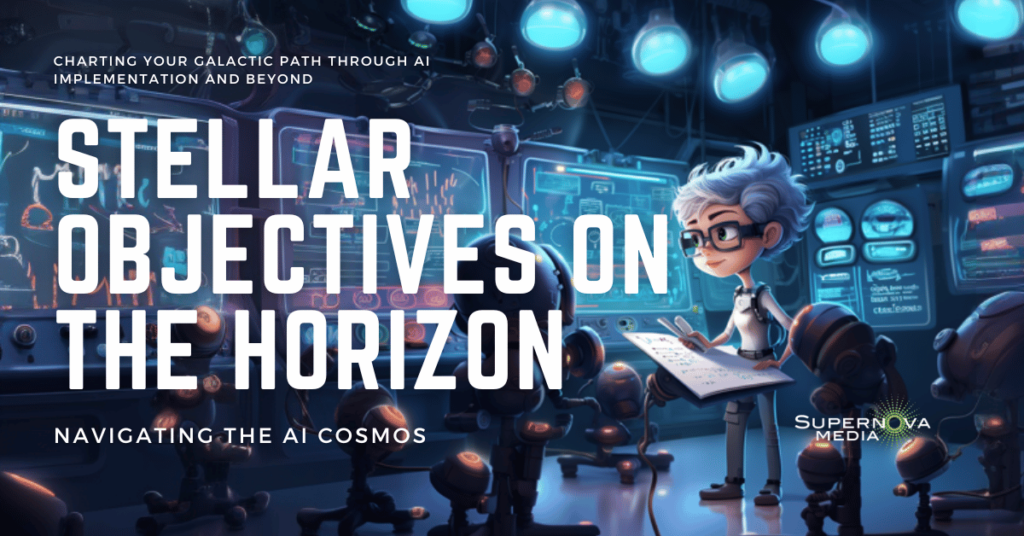
Hello, my courageous cosmic explorers! Captain Nancy here, your trusty guide through the AI cosmos, ready to launch into our exciting mission: Breaking down our interstellar journey to AI adoption. 🚀
Last time, we prepared the cosmic blueprint for our AI journey, outlining the ten pivotal questions to illuminate our path. Now, we’re ready to delve deeper into the first key aspect of our expedition: defining your objectives for AI in marketing.
Artificial intelligence (AI) is more than a fleeting comet in the marketing sky; it’s the rising sun that promises to illuminate every corner of our digital landscape. It’s our secret weapon against the increasing demands of our customers, who now expect hyper-personalized experiences delivered at lightspeed. Manual teams cannot keep pace with these astronomical expectations, especially at scale. It’s here that AI, with its ability to handle vast quantities of data and automate repetitive tasks at warp speed, comes to our rescue.
Establishing Goals
Setting your AI trajectory involves defining clear goals for your AI marketing program, like plotting the coordinates for a space journey. This might start with identifying areas within campaigns or operations that could be improved through leveraging AI. Establishing clear KPIs will then serve as your mission control, helping you gauge how successful the AI-augmented marketing campaign has been.
Our cosmic voyage often begins with identifying high-value, low-risk use cases. Always remember to keep a human in the loop, your loyal co-pilot who will ensure the AI technology is always aligned with your business’s core values and goals.
Defining Your Business Objectives
As you plan your trajectory, consider these key pointers to ensure a successful mission:
- Identify what you want to achieve: In the vast cosmos of AI possibilities, what do you want your AI starship to accomplish? Do you aim to increase sales, boost customer engagement, or heighten brand loyalty?
- Set measurable goals: Your AI starship needs precise coordinates. Ensure your goals are measurable to ascertain if you’ve reached your celestial destination.
- Understand your target audience: Understand the inhabitants of your brand’s universe. Align your objectives with their needs and interests for a harmonious AI journey.
- Choose the right AI marketing tools: Select the right AI-powered spacecraft for your journey. Whether it’s chatbots, personalization, or predictive analytics, make sure the tools align with your business objectives.
- Identify the metrics you will use to measure success: Set your AI star charts in order. Decide on the metrics you’ll use to measure the success of your objectives. Metrics might include conversion rates, click-through rates, or engagement rates.
Why and How to Set Realistic AI Goals
As we journey through the AI cosmos, our goals should reflect our company’s growth, like stars guiding us through the galaxy. We want to select AI objectives that increase our chances of success, prove value, and build a foundational space station from which we can launch more ambitious AI solutions.
The cosmos of AI marketing is inescapable, digital cosmonauts. Consider this: a whopping 76% of customers are broadcasting a clear signal from their spaceships: they expect companies to understand their needs and expectations. Feels like venturing into a black hole without a map, doesn’t it? That’s where AI becomes our North Star. It processes vast seas of marketing data from social media, emails, and the web at light speed. Simply put, AI is less a luxury and more of a lifeline in our ever-expanding digital universe.
And that’s it, brave cosmic explorers! We’ve plotted our first celestial coordinates on this vast AI journey. Our next mission will take us further into the cosmos, as we explore how AI can enhance your marketing strategies.
Keep your spirits high and your curiosity ignited, digital cosmonauts. The AI cosmos is filled with wonders waiting to be discovered! Until next time, this is Captain Nancy, signing off. 🚀














